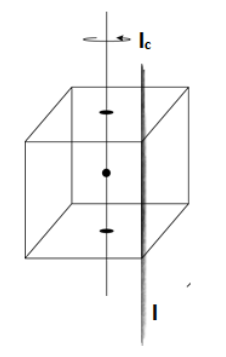Question
Question: The moment of inertia of a cube of mass M and edge length a about an axis passing through one of its...
The moment of inertia of a cube of mass M and edge length a about an axis passing through one of its edges is
A. 6Ma2
B. 3Ma2
C. 2Ma2
D. 32Ma2
Solution
The parallel axis theorem states that the Moment of Inertia of any body about an axis that is parallel to the axis passing through the centre is given by the formula provided. Also, the edge and axis passing through the centre of face and cube is parallel in a cube. And the moment of inertia of a cube of mass M and edge length about an axis passing through one of its centres is given below.
Formula used:
I=Ic+md2
Ic=6Ma2 for cube
Complete step by step answer:
We know that the moment of inertia of a cube of mass M and edge length a about an axis passing through one of its centres is
Ic=6Ma2
And we also know that the parallel axis theorem states that, the moment of Inertia of any body about an axis parallel to the axis passing through centre can be given as the sum of moment of inertia of body about the axis passing through the centre of the body and product of mass of the body times the square of distance between the two axes. It can be formulated as:
I=Ic+md2, where
I is the moment of inertia about an axis that is parallel to the axis passing through the centre
Icis the moment of inertia about an axis passing through the centre of the body
m is the mass of the body and
d is the distance between the axis passing through the centre and the axis parallel to it
Now coming to our question

We have Ic=6Ma2 and we need to find I
The distance between the axis and centre of the cube is 2a
Since, the edge and axis passing through the centre of face and cube is parallel in a cube so we can use parallel theorem, to get I.
Applying parallel theorem, I=Ic+md2 we get
